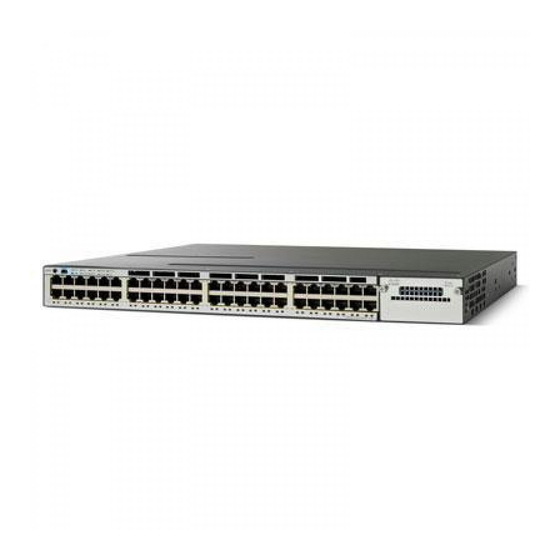Cisco Catalyst 3560-X Series Ficha de dados - Página 14
Procurar online ou descarregar pdf Ficha de dados para Interruptor Cisco Catalyst 3560-X Series. Cisco Catalyst 3560-X Series 29 páginas. Cisco catalyst 3560x-24p: specifications
Também para Cisco Catalyst 3560-X Series: Manual de iniciação (22 páginas)

Cross-Stack EtherChannel provides the ability to configure Cisco EtherChannel technology across different
●
members of the stack for high resiliency.
Flexlink provides link redundancy with convergence time less than 100 ms.
●
IEEE 802.1s/w Rapid Spanning Tree Protocol (RSTP) and Multiple Spanning Tree Protocol (MSTP) provide
●
rapid spanning-tree convergence independent of spanning-tree timers and also offers the benefit of Layer 2
load balancing and distributed processing. Stacked units behave as a single spanning-tree node.
Per-VLAN Rapid Spanning Tree (PVRST+) allows rapid spanning-tree reconvergence on a per-VLAN
●
spanning-tree basis, without requiring the implementation of spanning-tree instances.
Cisco Hot Standby Router Protocol (HSRP) is supported to create redundant, failsafe routing topologies.
●
Switch-port autorecovery (Errdisable) automatically attempts to reactivate a link that is disabled because of a
●
network error.
High-Performance IP Routing
Cisco Express Forwarding hardware routing architecture delivers extremely high-performance IP routing in the Cisco
Catalyst 3750-X and 3560-X Series Switches.
IP unicast routing protocols (Static, Routing Information Protocol Version 1 [RIPv1], and RIPv2, RIPng,
●
EIGRP stub) are supported for small-network routing applications with IP Base feature set.
Advanced IP unicast routing protocols (OSPF, EIGRP, BGPv4, and IS-ISv4) are supported for load balancing
●
and constructing scalable LANs. IPv6 routing (OSPFv3, EIGRPv6) is supported in hardware for maximum
performance. The IP Services feature set is required.
Equal-cost routing facilitates Layer 3 load balancing and redundancy across the stack.
●
Policy-based routing (PBR) allows superior control by facilitating flow redirection regardless of the routing
●
protocol configured. The IP Services feature set is required.
Hot Standby Routing Protocol (HSRP) provides dynamic load balancing and failover for routed links, up to 32
●
HSRP links supported per unit or stack.
Protocol Independent Multicast (PIM) for IP multicast routing is supported, including PIM sparse mode (PIM-
●
SM), PIM dense mode (PIM-DM), PIM sparse-dense mode and Source Specific Multicast (SSM). The IP
Services feature set is required.
Virtual routing and forwarding (VRF)-Lite enables a service provider to support two or more VPNs, with
●
overlapping IP addresses. IP Services feature set is required.
Superior Quality of Service
The Cisco Catalyst 3750-X and 3560-X Series offers GbE speed with intelligent services that keep everything flowing
smoothly, even at 10 times the normal network speed. Industry-leading mechanisms for marking, classification, and
scheduling deliver superior performance for data, voice, and video traffic, all at wire speed.
Following are some of the QoS features supported in the Cisco Catalyst 3750-X and 3560-X Series Switches:
Cross-stack QoS allows QoS to be configured across the entire stack.
●
802.1p class of service (CoS) and differentiated services code point (DSCP) field classification are provided,
●
using marking and reclassification on a per-packet basis by source and destination IP address, MAC
address, or Layer 4 TCP/UDP port number.
Cisco control-plane and data-plane QoS ACLs on all ports help ensure proper marking on a per-packet basis.
●
Eight egress queues per port help enable differentiated management of different traffic types across the
●
stack. Four queues are user configurable and four are reserved for system use.
© 2010 Cisco and/or its affiliates. All rights reserved. This document is Cisco Public Information.
Data Sheet
Page 14 of 28
